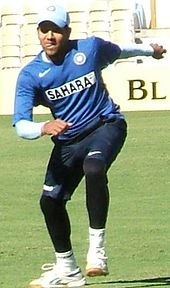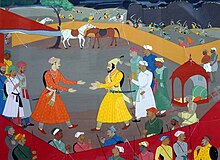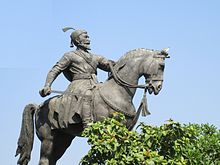This unexpected and unlikely victory made Shivaji a hero of Maratha folklore and a legendary figure among his people. The large quantities of captured weapons, horses, armour and other materials helped to strengthen the nascent and emerging Maratha army. The Mughal emperor
Aurangzeb now identified Shivaji as a major threat to the mighty
Mughal Empire. Soon thereafter Shivaji, Shahaji and Netaji Palkar (the chief of the Maratha cavalry) decided to attack and defeat the Adilshahi kingdom at Bijapur.
Treaty of Purandar-
Attack on Shahista khan and Surat, enraged the Mughal emperor, Aurangzeb. In response he sent Mirza Raja
Jai Singh I with an army numbering around 150,000 to defeat Shivaji. Jai Singh's forces made significant gains and captured many Maratha forts, forcing Shivaji to come to terms with Aurangzeb rather than lose more forts and men.
In the
Treaty of Purandar, signed between Shivaji and Jai Singh on 11 June 1665, Shivaji agreed to give up 23 of his forts and pay compensation of 400,000 rupees to the Mughals. He also agreed to let his son
Sambhaji become a Mughal sardar, serve the Mughal court of Aurangzeb and fight alongside the Mughals against Bijapur. One of Shivaji's commander, Netaji Palkar joined the Mughals, was rewarded very well for his bravery, converted to Islam, changed his name to Quli Mohammed Khan in 1666 and was sent to the Afghan frontier to fight the restive tribes. He returned to Shivaji's service in 1676 after ten years with the Mughals, and was accepted back as a Hindu on Shivaji's advice.
Arrest in Agra and escape
In 1666, Aurangzeb invited Shivaji to
Agra, along with his nine-year-old son Sambhaji. Aurangzeb's plan was to send Shivaji to
Kandahar, now in Afghanistan, to consolidate the Mughal empire's northwestern frontier. However, in the court, on 12 May 1666, Aurangzeb made Shivaji stand behind
mansabdārs (military commanders) of his court. Shivaji took offence and stormed out of court, and was promptly placed under house arrest under the watch of Faulad Khan, Kotwal of Agra.
Shivaji feigned severe illness and requested to send most of his contingent back to the Deccan, thereby ensuring the safety of his army and deceiving Aurangzeb. Thereafter, on his request, he was allowed to send daily shipments of sweets and gifts to saints, fakirs, and temples in Agra as offerings for his health.According to the Mughal documents,after several days and weeks of sending out boxes containing sweets, Shivaji, disguised as labourer carrying sweet basket escaped on 17 August 1666. Sambhaji, being a child had no restrictions and was sent out of the prison camp before Shivaji escaped After escaping Shivaji and his son fled to the Deccan disguised as
sadhus (holy men). Popular legends claim that Shivaji and Sambhaji escaped by sitting inside boxes that contained sweets to temples in Agra.Recent research has proposed that Shivaji simply disguised himself as a Brahmin priest after performance of religious rites at the
haveligrounds on 22 July 1666, and escaped by mingling within the departing priestly entourage of Pandit Kavindra Paramananda. Sambhaji was removed from Agra and taken to Mathura later by Shivaji's trusted men.
Peace with Mughals-
After Shivaji's escape, hostilities with the Mughals ebbed with Mughal sardar Jaswant singh acting as intermediary between Shivaji and Aurangzeb for new peace proposals.During the period between 1668 and 1670, Aurangzeb conferred the title of Raja on Shivaji. Sambhaji was also restored as a Mughal mansabdar with 5000 horses. Shivaji at that time sent Sambhaji with General
Prataprao Gujar to serve with Mughal viceroy in Aurangabad, Prince Muazzam. Sambhaji was also granted territory in
Berar for revenue collection. Aurangzeb also permitted Shivaji to attack the decaying Adil Shahi. The weakened Sultan
Ali Adil Shah II sued for peace and granted the rights of
Sardeshmukhi and
Chauthai to Shivaji.
Reconquest-
The peace between Shivaji and the Moghuls lasted until the end of 1670. At that time Aurangzeb got suspicious of the close ties between Shivaji and Prince Muazzam who he thought might usurp his throne.Also at that time, Aurangzeb greatly reduced his army in the Deccan.The disbanded soldiers quickly joined Maratha service.The Mughals also took away the jagir of Berar from Shivaji to recover the money lent to him a few years earlier. In response to this situation, Shivaji launched an offensive against the Moghuls and recovered a major portion of the territories surrendered to them in a span of four months. During this phase,
Tanaji Malusare won the fort of
Sinhgad in the
Battle of Sinhagad on 4 Feb 1670, dying in the process. Shivaji sacked Surat for second time in 1670; while he was returning from Surat, Mughals under Daud Khan tried to intercept him, but were defeated in the Battle of Vani-Dindori near present-day
Nashik.
Dealings with the English-
In October 1670, Shivaji sent his forces to harass the English at Bombay; as they had refused to sell him war material, his forces blocked Bombay's woodcutting parties. In September 1671, Shivaji sent an ambassador to Bombay, again seeking material, this time for the fight against Danda-Rajpuri; the English had misgivings of the advantages Shivaji would gain from this conquest, but also did not want to lose any chance of receiving compensation for his looting their factories at Rajapur. The English sent Lieutenant Stephen Ustick to treat with Shivaji, but negotiations failed over the issue of the Rajapur indemnity. Numerous exchanges of envoys followed over the coming years, with some agreement as to the arms issues in 1674, but Shivaji was never to pay the Rajpur indemnity before his death, and the factory there dissolved at the end of 1682.
When Shivaji went to
Tanjore to fight his half-brother Venkoji (Ekoji I), he met the English at
Madras (then known as Madraspatnam) on 3 October 1677 as stated in a plaque in the Kalikambal temple, located on Thambu Chetty Street in George Town. The
East India Company officials who looked after the fort at that time have recorded that Shivaji came up to the gates of Fort St. George and had sought the services of the English engineers but the request was politely turned down.
Maratha empire carried out a number of sea raids, such as plunders targeting Mughal
pilgrim ships and European trading vessels. European traders described these attacks as
piracy, but the Marathas viewed them as legitimate targets because they were trading with, and thus financially supporting, their Mughal and Bijapur enemies. After the representatives of various European powers signed agreements with Shivaji or his successors that the threat of plundering or raids against Europeans began to reduce.
Battle of Nesari-
In 1674,
Prataprao Gujar, the then commander-in chief of the Maratha forces, was sent to push back the invading force led by the Adilshahi general,
Bahlol Khan. Prataprao's forces defeated and captured the opposing general in the battle, after cutting-off their water supply by encircling a strategic lake, which prompted Bahlol Khan to sue for peace. In spite of Shivaji's specific warnings against doing so Prataprao released Bahlol Khan, who started preparing for a fresh invasion.
Shivaji sent a displeased letter to Prataprao, refusing him audience until Bahlol Khan was re-captured. In the ensuing days, Shivaji learnt of Bahlol Khan having camped with 15,000 force at Nesari near Kolhapur. Not wanting to risk losing his much smaller Maratha force entirely, Prataprao and six of his sardars attacked in a suicide mission, buying time for Anandrao Mohite to withdraw the remainder of the army to safety. The Marathas avenged the death of Prataprao by defeating Bahlol Khan and capturing his jagir (fiefdom) under the leadership of Anaji and Hambirao Mohite. Shivaji was deeply grieved on hearing of Prataprao's death; he arranged for the marriage of his second son, Rajaram, to Prataprao's daughter. Anandrao Mohite became Hambirrao Mohite, the new sarnaubat (commander-in-chief of the Maratha forces). Raigad Fort was newly built by Hiroji Indulkar as a capital of nascent Maratha kingdom.
Coronation-

The coronation of Shivaji
Shivaji had acquired extensive lands and wealth through his campaigns, but lacking a formal title he was still technically a Mughal zamindar or the son of an Adilshahi jagirdar, with no legal basis to rule his de facto domain. A kingly title could address this, and also prevent any challenges by other Maratha leaders, to whom he was technically equal; it would also provide the Hindu Marathas with a fellow Hindu sovereign in a region otherwise ruled by Muslims.
Shivaji was crowned king of the Marathas in a lavish ceremony at Raigad on 6 June 1674. In the
Hindu calendar it was on the 13th day (
trayodashi) of the first fortnight of the month of
Jyeshtha in the year 1596.
Pandit Gaga Bhatt officiated, holding a gold vessel filled with the seven sacred waters of the rivers
Yamuna,
Indus,
Ganges,
Godavari,
Krishna and
Kaveri over Shivaji's head, and chanted the coronation mantras. After the ablution, Shivaji bowed before Jijabai and touched her feet. Nearly fifty thousand people gathered at Raigad for the ceremonies. Shivaji was bestowed with the sacred thread
jaanva, with the
Vedas and was bathed in an
abhisheka. Shivaji was entitled
Shakakarta ("founder of an era")and
Kshatriya Kulavantas ("head of
Kshatriyas"), and
Chhatrapati ("paramount sovereign"). He also took the title of "Haindava Dharmodhhaarak".
His mother Jijabai died on 18 June 1674, within a few days of the coronation. Considering this a bad omen, a second coronation was carried out 24 September 1674, this time according to the Bengali school of Tantricism and presided over by Nischal Puri.
The state as Shivaji founded it was a Maratha kingdom comprising about 4.1% of the subcontinent at the time he died, but over time it was to increase in size and heterogeneity, and by the time of the Peshwas in the early 18th century the Marathas were dominant across the northern and central regions of the Indian subcontinent.
Conquest in Southern India-
Beginning in 1674, the Marathas undertook an aggressive campaign, raiding
Khandesh (October), capturing Bijapuri
Ponda (April 1675),
Karwar (mid-year), and Kolhapur (July). In November the Maratha navy skirmished with the
Siddis of
Janjira, and in early 1676 Peshwa Pingale, en route to Surat, engaged the Raja of Ramnagar in battle.Shivaji raided
Athani in March 1676, and by year's end besieged
Belgaum and Vayem Rayim in modern-day northern Karnataka. At the end of 1676, Shivaji launched a wave of conquests in southern India, with a massive force of 30,000 cavalry and 20,000 infantry. He captured the Adilshahi forts at
Vellore and
Gingee, in modern-day
Tamil Nadu. In the run-up to this expedition Shivaji appealed to a sense of Deccani patriotism, that the "Deccan" or Southern India was a homeland that should be protected from outsiders.His appeal was somewhat successful and he entered into a treaty with the
Qutubshah of the
Golconda sultanate that covered the eastern Deccan. Shivají's conquests in the south proved quite crucial during future wars; Gingee served as Maratha capital for nine years during the Maratha War of Independence.
Shivaji intended to reconcile with his half-brother
Venkoji (Ekoji I), Shahaji's son by his second wife, Tukabai (née
Mohite), who ruled Thanjavur (Tanjore) after Shahaji. The initially promising negotiations were unsuccessful, so whilst returning to Raigad Shivaji defeated his half-brother's army on 26 November 1677 and seized most of his possessions in the
Mysore plateau. Venkoji's wife Dipa Bai, whom Shivaji deeply respected, took up new negotiations with Shivaji, and also convinced her husband to distance himself from Muslim advisors. In the end Shivaji consented to turn over to her and her female descendants many of the properties he had seized, with Venkoji consenting to a number of conditions for the proper administration of the territories and maintenance of Shivaji's future Memorial (Samadhi).
Death and succession-

Sambhaji, Shivaji's elder son who succeeded him
The question of Shivaji's heir-apparent was complicated by the misbehaviour of his eldest son Sambhaji, who was irresponsible and "addicted to sensual pleasures." Unable to curb this, Shivaji confined his son to Panhala in 1678, only to have the prince escape with his wife and defect to the Mughals for a year. Sambhaji then returned home, unrepentant, and was again confined to Panhala.
In late March 1680, Shivaji fell ill with fever and dysentery,dying around 3–5 April 1680 at the age of 52, on the eve of
Hanuman Jayanti.
Putalabai, the childless eldest of the surviving wives of Shivaji committed
sati by jumping in his funeral pyre. The other surviving spouse, Sakwarbai, was not allowed to follow suit because she had a young daughter. Rumours followed Shivaji's death, with Muslims opining he had died of a curse from
Jan Muhammad of Jalna, and some Marathas whispering that
Soyarabai, the youngest of the three wives who survived him, had poisoned him so that his crown might pass to her 10-year-old son
Rajaram.After Shivaji's death, Soyarabai made plans with various ministers of the administration to crown her son Rajaram rather than her prodigal stepson Sambhaji. On 21 April 1680, ten-year-old Rajaram was installed on the throne. However, Sambhaji took possession of the
Raigad Fort after killing the commander, and on 18 June acquired control of Raigad, and formally ascended the throne on 20 July. Rajaram, his wife Janki Bai, and mother Soyrabai were imprisoned, and Soyrabai executed on charges of conspiracy that October.
Follow on Twitter-
https://twitter.com/RushikeshKardi2
 Sachin Ramesh Tendulkar born in 24 April 1973 is a former Indian cricketer and a former captain, regarded as one of the greatest batsmen of all time.The highest run scorer of all time in International cricket, Tendulkar took up cricket at the age of eleven, made his Test debut on 15 November 1989 against Pakistan in Karachi at the age of sixteen, and went on to represent Mumbai domestically and India internationally for close to twenty-four years. He is the only player to have scored one hundred international centuries, the first batsman to score a double century in a One Day International, the holder of the record for the most number of runs in both ODI and Test cricket, and the only player to complete more than 30,000 runs in international cricket.
Sachin Ramesh Tendulkar born in 24 April 1973 is a former Indian cricketer and a former captain, regarded as one of the greatest batsmen of all time.The highest run scorer of all time in International cricket, Tendulkar took up cricket at the age of eleven, made his Test debut on 15 November 1989 against Pakistan in Karachi at the age of sixteen, and went on to represent Mumbai domestically and India internationally for close to twenty-four years. He is the only player to have scored one hundred international centuries, the first batsman to score a double century in a One Day International, the holder of the record for the most number of runs in both ODI and Test cricket, and the only player to complete more than 30,000 runs in international cricket.











